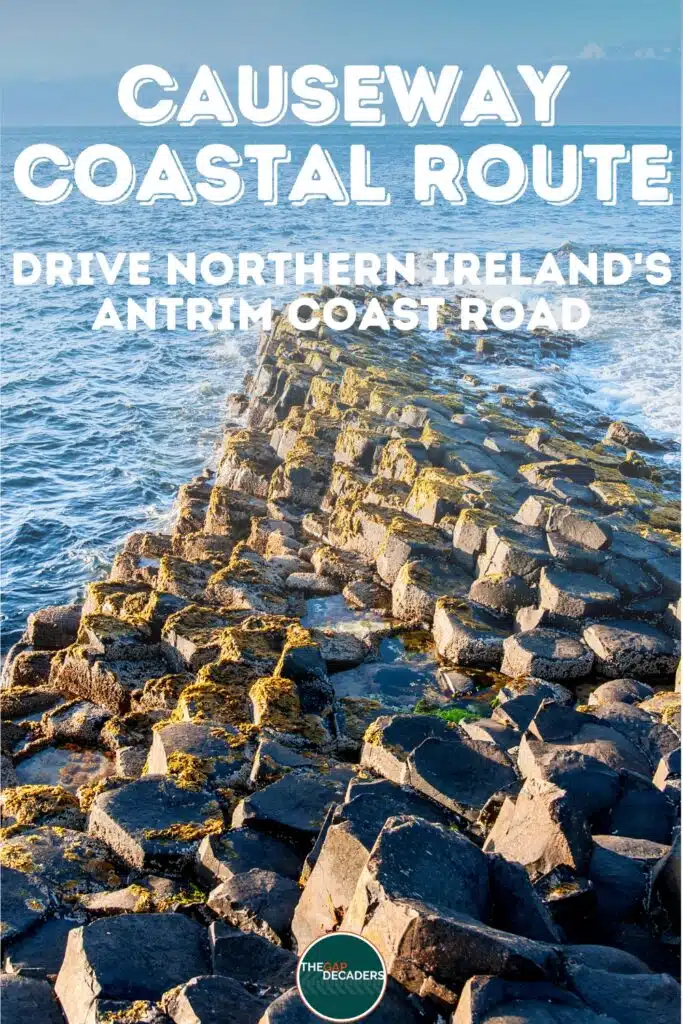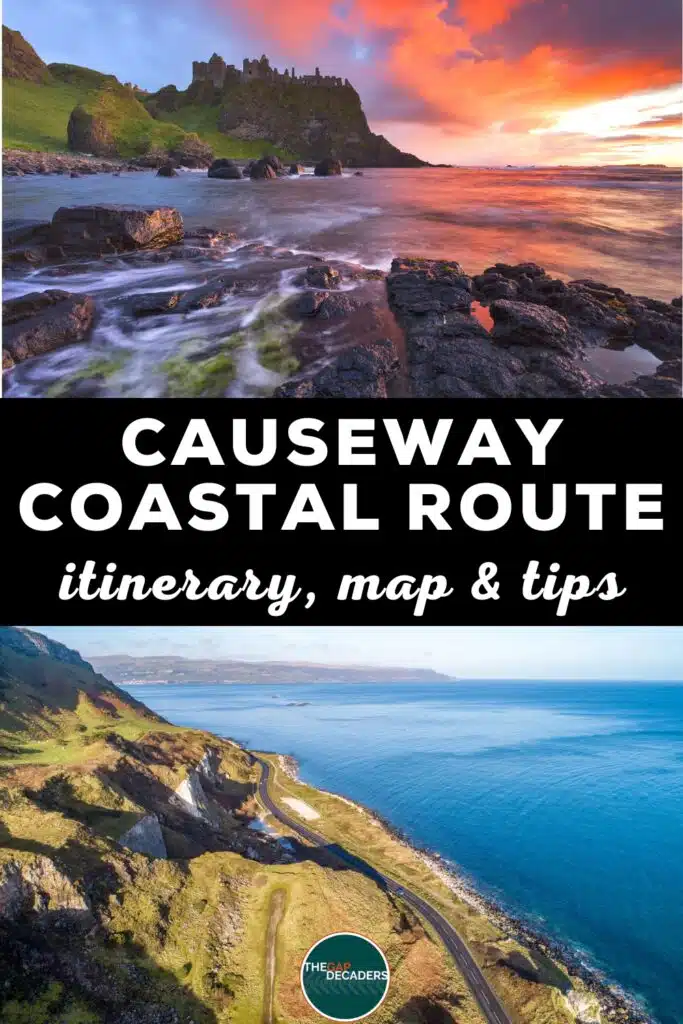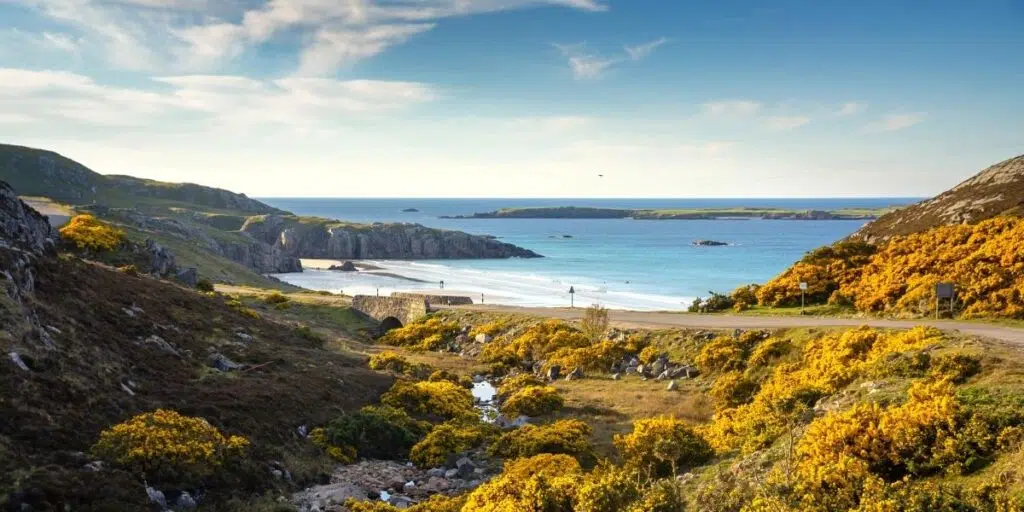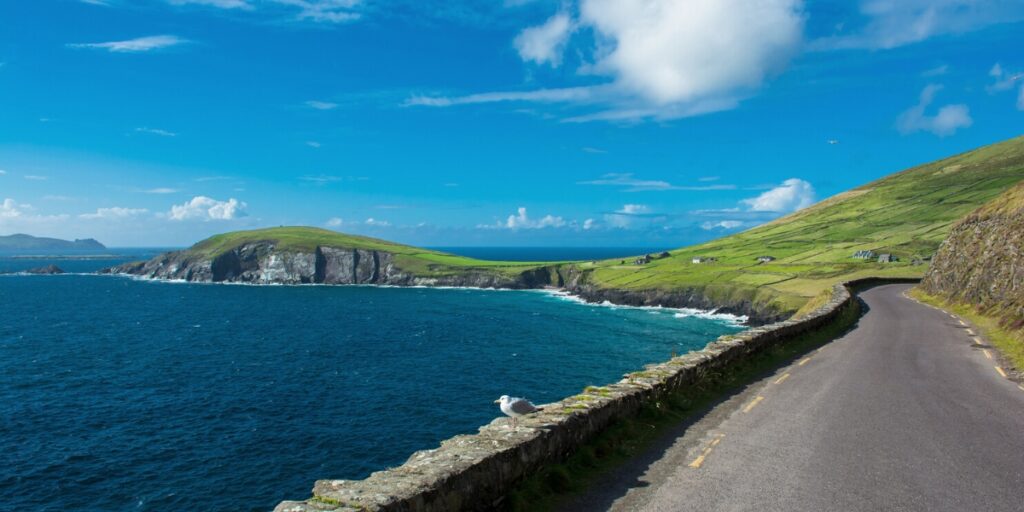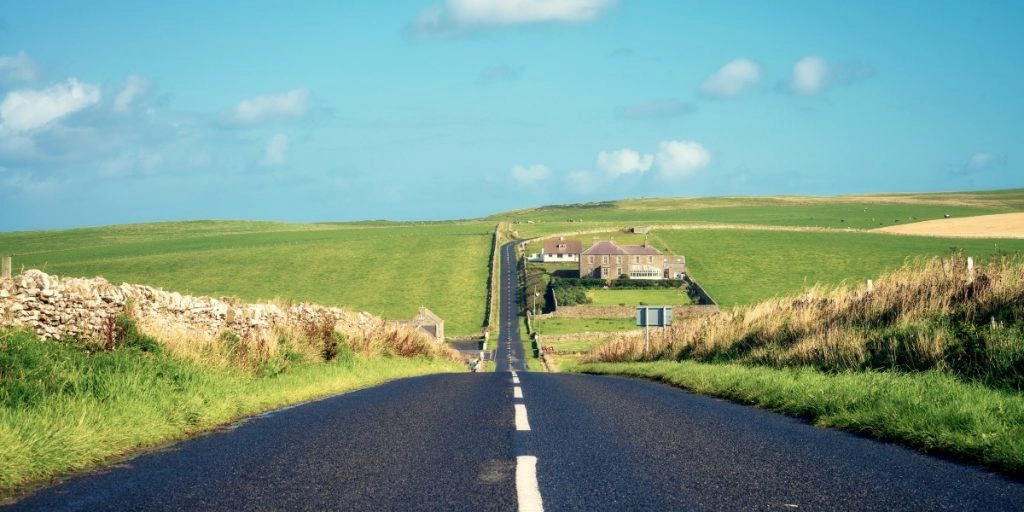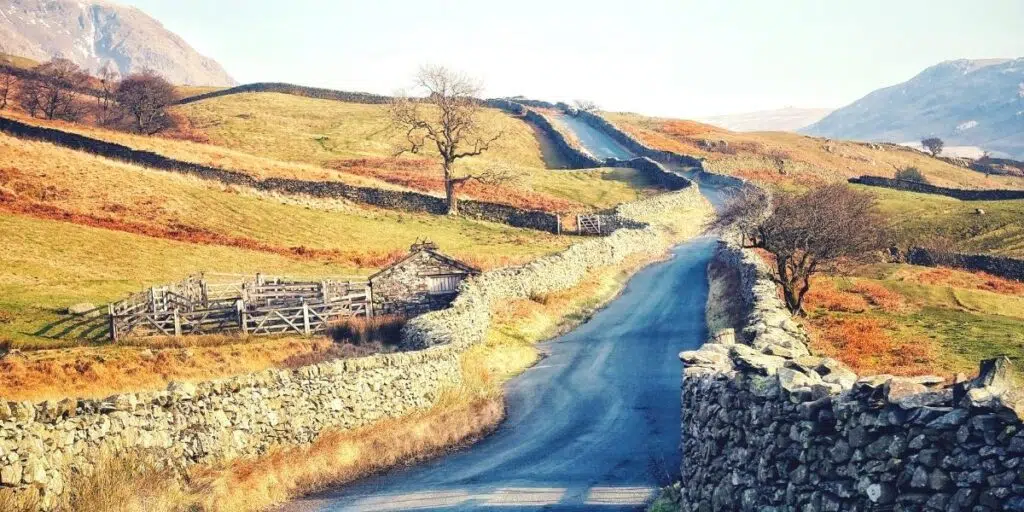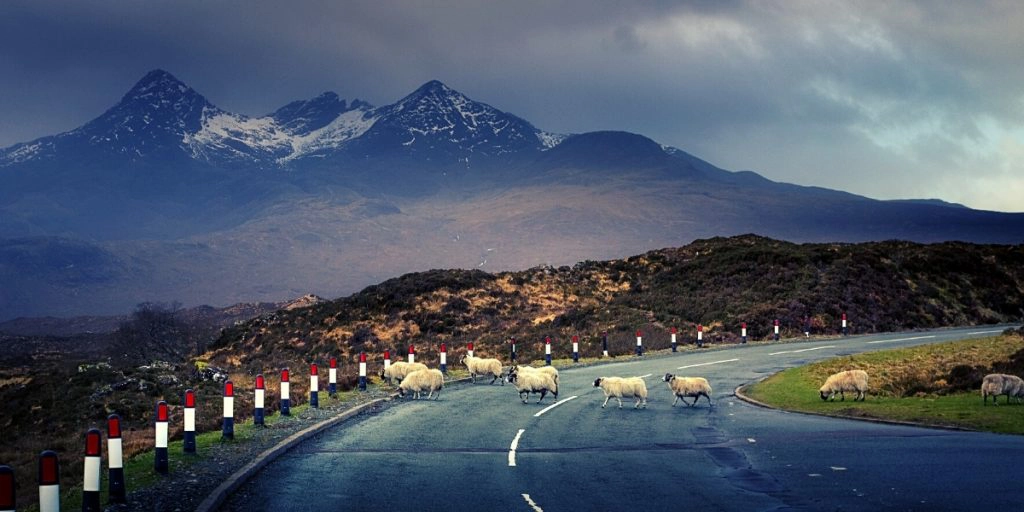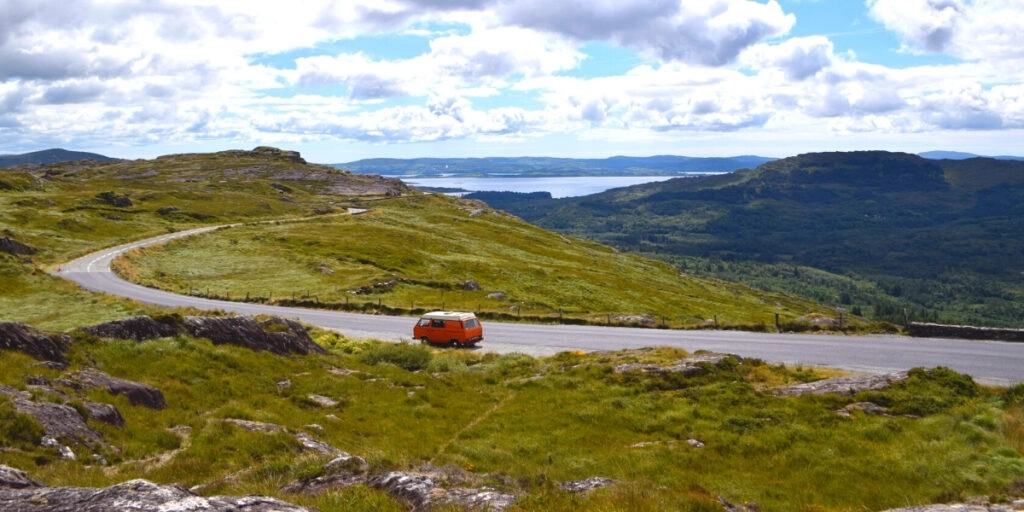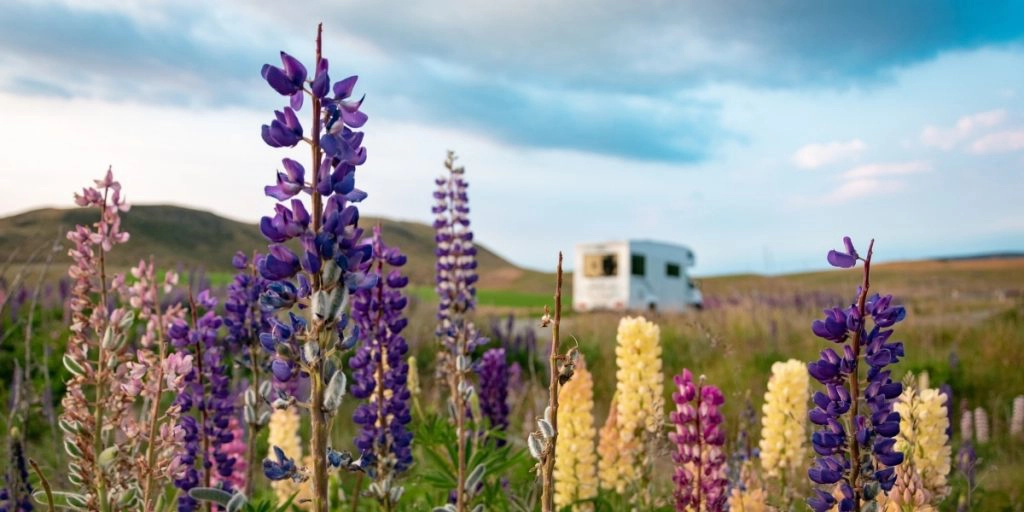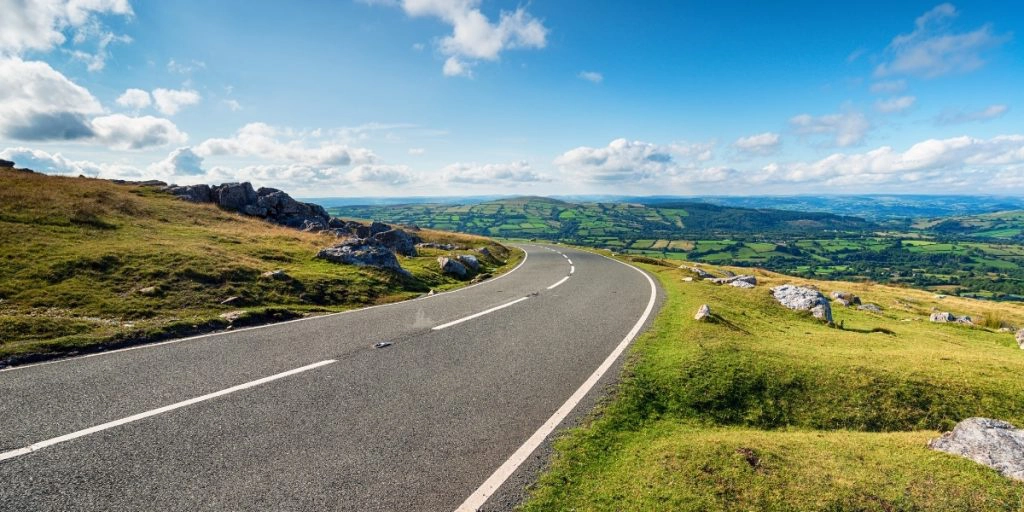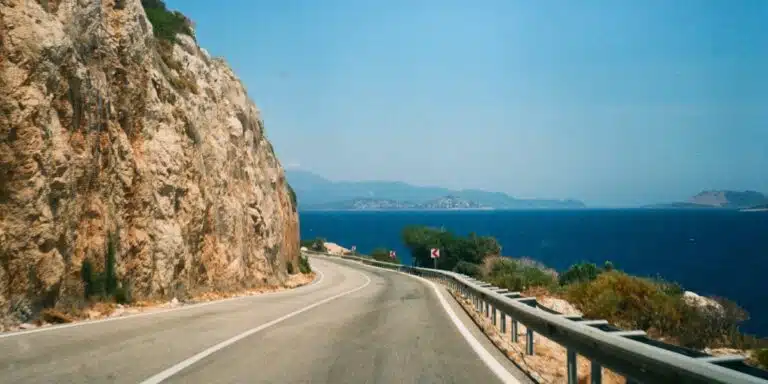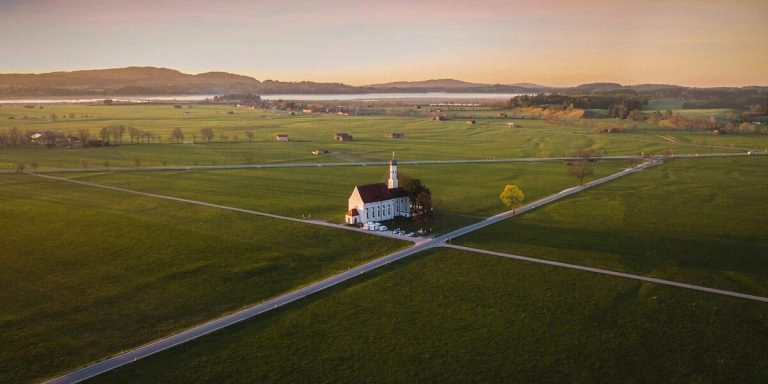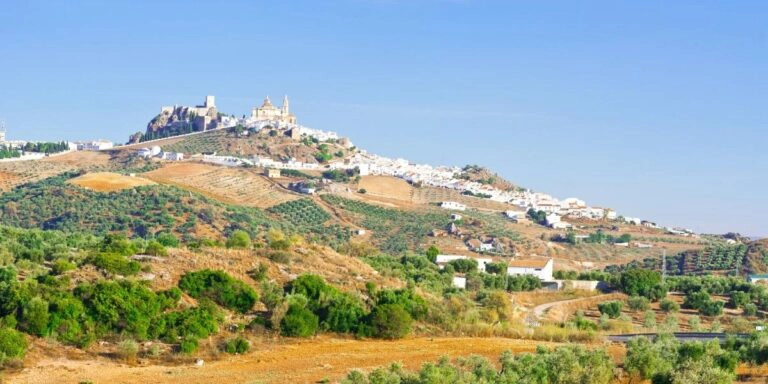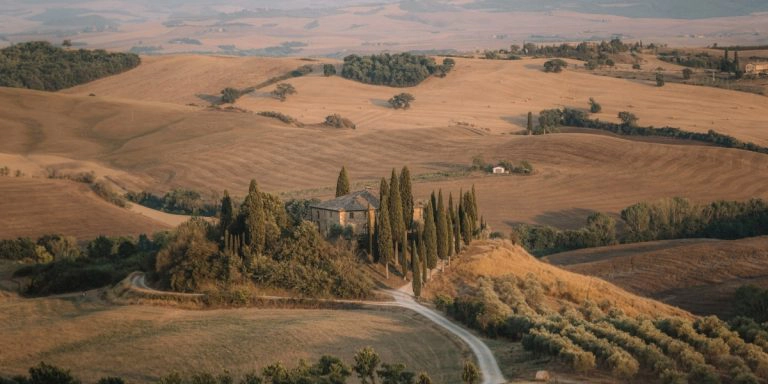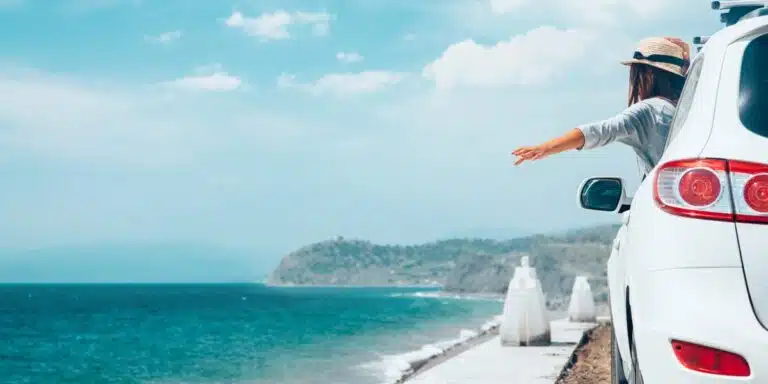This post may contain affiliate links, from which we earn an income. Click here to read our affiliate policy.
The Causeway Coastal Route is a spectacular road that hugs the Antrim coast between Belfast and Londonderry in Northern Ireland. Offering breathtaking views, must-see stops, and legendary hospitality, driving this route is an unforgettable experience.
From remarkable UNESCO World Heritage Sites to huge sandy beaches and lively seaside towns, this Causeway Coast road trip is packed with unforgettable sights and activities whether you’re a nature lover, Game of Thrones fan, history buff, or like an eclectic mix.
But is the Causeway Coastal Route the best road trip in Ireland? In our guide, we’ll share the route and map, insider travel tips, must-see destinations, and practical advice to help you plan your own epic adventure and decide for yourself. So buckle up and get ready to hit the road with us on an unforgettable journey along the Causeway Coastal Route!
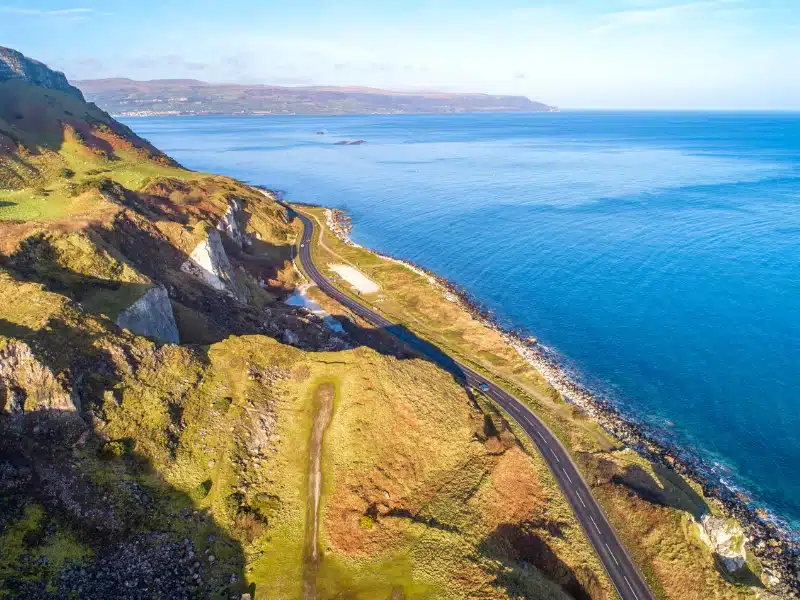
What is the Causeway Coastal Route?
The Causeway Coastal Route is a scenic road trip that stretches along the coast of Northern Ireland, from the capital city of Belfast to the second city of Derry/Londonderry. We think it’s one of the best road trips in Europe!
The Causeway Coast Northern Ireland route covers approximately 130 miles / 209km and showcases the remarkable Antrim Coast Road, which boasts a rich tapestry of natural beauty, historical sites, and quaint seaside towns.
Where is Northern Ireland?
Northern Ireland (or ‘Norn Iron’ as it is affectionately known by residents) is a part of the United Kingdom of Great Britain and Northern Ireland, also known as the UK. The other countries in this sovereign state are England, Scotland, and Wales.
Ireland is a completely separate and independent country (and a member of the EU) officially described as the Republic of Ireland. There is no such country as Southern Ireland, although it is often incorrectly used to differentiate between Ireland and Northern Ireland.
Often, people refer to the ‘island of Ireland’ as a way of showing solidarity between two separate countries which occupy the same landmass.
Is this your first time visiting the United Kingdom? Get all the information you need in our UK Travel Guide, including what to pack, the best time of year to go, getting there, and practical tips to help you have the best trip!
Getting There
Fly to Northern Ireland
The Causeway Coastal Route officially starts in Belfast, Northern Ireland’s friendly capital city, although you could do the route in reverse and start in Derry/Londonderry, the official finish point of the Causeway Coastal Route.
To start in Belfast, fly into Belfast International Airport or George Best Belfast City Airport, both of which have direct flight connections with most of Europe.
To start in Derry/Londonderry, fly into the City of Derry Airport from London Stansted, Manchester, Glasgow, and Liverpool in the United Kingdom, and Majorca in Spain, or into Donegal Airport from Dublin and Glasgow.
We recommend booking through Skyscanner for live deals and the best prices.
Drive to Northern Ireland
Alternatively, you can take your own car, motorbike, or camper to Northern Ireland from the UK by ferry. There is no direct ferry to Northern Ireland from Europe but you could sail to Dublin, Rosslare, or Cork from France and drive to Northern Ireland.
Use Direct Ferries to compare and book the best crossings to Northern Ireland from;
- Liverpool Birkenhead to Belfast
- Cairnryan to Belfast
- Cairnryan to Larne
Make sure you have travel insurance you can trust when visiting Northern Ireland. We recommend True Traveller for their 5-star TrustPilot reviews, variety of cover options, best activities cover as standard, great prices, and excellent service.
How to Travel the Causeway Coastal Route
Self-Drive
Whether you’re in a car, motorcycle, campervan, or motorhome, self-driving is absolutely the best way to explore Northern Ireland’s Coastal Causeway Route, meaning you can stop whenever you want, try new activities, visit places you see along the route, and have the freedom to change plans at the last minute.
Are you planning to rent a car in Northern Ireland? As one of the largest car hire aggregator companies in the world, we recommend Rentalcars.com because they have massive purchasing power which enables them to secure the best rental car prices, which benefits you when you’re planning your Northern Ireland coastal route drive.
For a real adventure, hire a motorhome or campervan in Northern Ireland. We recommend Motorhome Republic, an aggregate booking site who pull together all the best deals from a number of rental agencies, to offer you a wide choice of options alongside an excellent English speaking expert motorhome Concierge Team.
Use the Park4Night app to find overnight spots and campsites, and wild camp surrounded by fields, on the edge of a beach or with incredible sea views.
Causeway Coastal Route Public Transport
It is possible to travel much of the Causeway Coastal Route without a car using Northern Ireland’s bus and train network.
You won’t be able to follow the whole coastal road route with public transport, but with a bit of planning, you will be able to get between towns and attractions along the route.
The Goldline Coach Service 221 takes you directly to the Giant’s Causeway Visitor Centre from Belfast’s Europa Buscentre. From this same station during July and August, you can also catch the Ulsterbus 252 and travel north through the beautiful Antrim Coast and Glens.
Ulsterbus has a really helpful interactive map that you can use to search for bus routes by region and operator along the Causeway Coastal road.
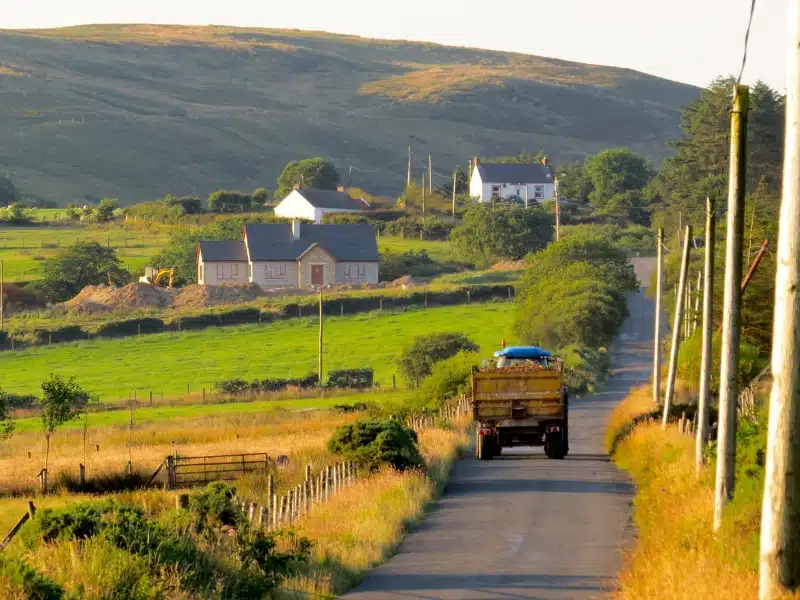
Looking for the best SIM card deals in Europe for your trip? Check out our guide to the best data SIMs in Europe and get the best deal for your trip to Northern Ireland.
Causeway Coastal Route Tours
There are plenty of multi-day and day trips from Belfast to the most scenic and interesting parts of the Causeway Coastal Route, which are well worth doing if you’re short of time, or don’t want to drive the route yourself.
These are our picks of the top recommended Causeway Coastal Route trips from Belfast.
Causeway Coastal Route Map & Route
Our seven day Causeway Coastal Route starts in Belfast and heads north, hitting all the top spots and highlights along the route. We know that you probably won’t be able to visit all the attractions on our itinerary, but pick out what interests you most and focus on those, to get the best from this coastal route experience.
- Lonely Planet Ireland
- Round the Hidden Coast of Northern Ireland From A to Z
- Rick Steves Snapshot of Northern Ireland
Belfast – Glenariff – Ballycastle – Bushmills – Portstewert – Derry/Londonderry
How to use this map – Use your fingers (or computer mouse) to zoom in and out. Click or touch the icons to get more info about a place, and click the arrow in the box top left to open the index. To add to your own Google Maps account, click the star next to the title of the map.
Causeway Coastal Route Itinerary
Day 1: Belfast
Belfast is a vibrant city that has overcome its troubled past and transformed into a must-visit destination. The capital of Northern Ireland marks the beginning of the Causeway Coastal Route.
Belfast offers rich historical and cultural experiences, such as the Titanic Belfast Museum in the Titanic Quarter, where you can learn the story of the legendary ocean liner and her fateful journey across the Atlantic. You’ll need to book in advance as this is a super-popular experience.
Another must-do experience is a vist to the Crumlin Road Gaol, where you can journey through Northern Ireland’s only remaining Victorian-era prison. Hear the stories of the murderers, suffragettes, loyalists and republican prisoners who were jailed here and learn about the births, executions, hunger strikes and riots that have taken place within the prison walls.
Make sure to take this highly-rated Belfast Political Taxi Tour in a black cab to learn about Belfast and the Troubles, and visit the peace wall and political murals in the Falls and Shankill.
Visitors can also enjoy the stunning Baroque Revival architecture of Belfast City Hall before wandering the historic Victorian St George’s Market to sample local produce and pick up unique gifts and souvenirs of Northern Ireland.
RELATED POST: Belfast in A Day: Itinerary, Map & Tips
Upmarket: The Merchant Hotel – Booking.com | Agoda
Mid-Range: Malmaison Belfast – Booking.com | Agoda
Budget: Vagabonds Hostel – Booking.com | Agoda
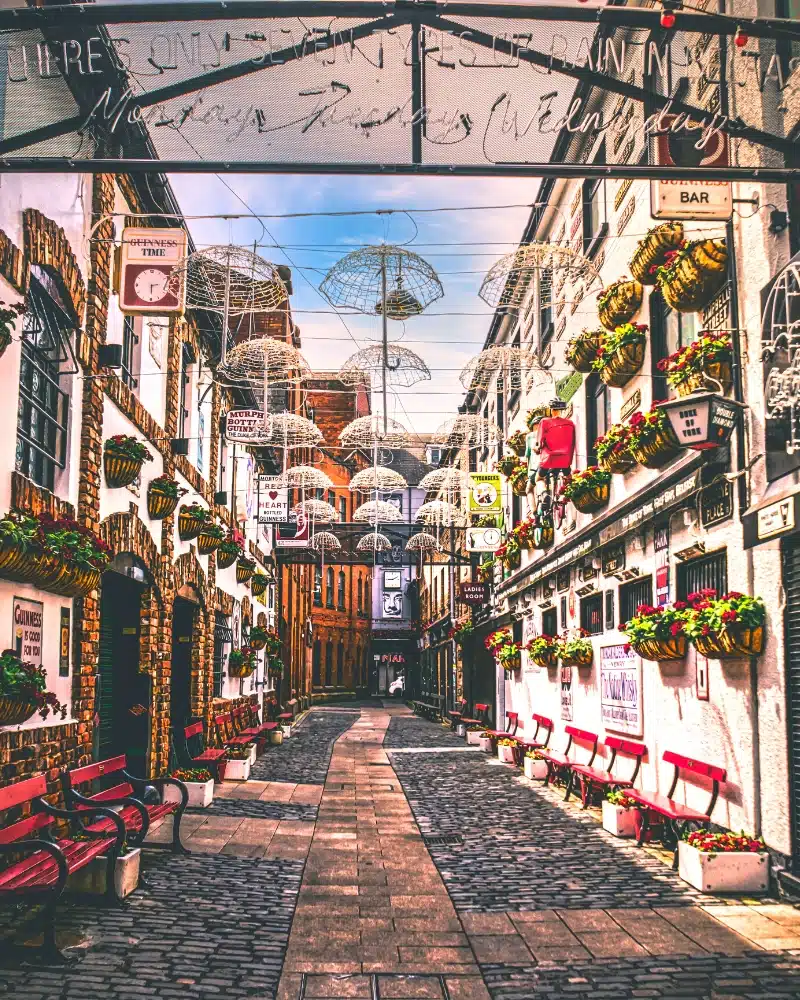
Day 2: Belfast to Glenariff
Today is a busy one, so make sure to be up and on the road early!
Carrickfergus Castle
Built by the Normans in 1177, Carrickfergus Castle was situated strategically on a rocky promontory, originally almost completely surrounded by sea and commanding Carrickfergus Bay, now known as Belfast Lough. Today there is less water around the castle due to land reclamation, and the town of Carrickfergus sits under its shadow.
Besieged over the centuries by the Scots, native Irish, English, and French, the castle played an important military role and remains one of the best-preserved medieval structures in Ireland. The castle now houses historical displays as well as cannons from the 17th to the 19th centuries and is worth popping in as you pass by.
The Gobbins Cliff Path
Just a short drive north, the Gobbins Cliff Path offers a unique walking experience along the stunning coastline at Islandmagee.
The Gobbins Cliff Path is physically challenging and requires a moderate level of fitness, so come prepared with proper footwear and weather-appropriate clothing. The cliff-face path runs across bridges, past caves, and through a tunnel, along the Gobbins cliffs, which are recognized for their rich birdlife, important geology, and notable species.
This brilliant attraction provides adventurers with an opportunity to explore the dramatic cliffs, caves, and fauna of the Causeway Coastal Route. Guided tours are available for those interested in learning more about the area’s geology, history, and wildlife.
GoT Location: Magheramorne Quarry
Northern Ireland has no less than nine Game of Thrones filming locations and you’ll be passing the first two today.
Magheramorne Quarry primarily served as the set for Castle Black and the Wall. The quarry’s rugged landscape provided the perfect backdrop for the Night’s Watch headquarters, but it’s closed to the public.
We have heard that if you head off the A2 just past Whitehead on the B150 and take the Low Road for around 3 miles / 5km there are views across the inlet to the quarry. We haven’t tried this so don’t blame us if you can’t see a thing!
GoT Location: Sallagh Braes
Further along the coast, Sallagh Braes was featured in Game of Thrones as the lands of House Tully. A dramatic basalt scarp with a spectacular ballast amphitheater made it an ideal setting for the Riverlands – but even if you’re not a GoT fan, the breathtaking landscape is worth exploring.
Take the short 1.8 mile / 2.9km Sallagh Braes walk across the Antrim plateau to the escarpment and see how many scenes from GoT seasons 1, 4, and 5 you recognize!
Glenarm Castle
The ancestral home of the Earl of Antrim, Glenarm Castle was built in 1636 by Randal MacDonnell, 1st Earl of Antrim, but was burned by a Scots Covenanter army in 1642.
The castle remained a roofless ruin for ninety years before being rebuilt. Today, Glenarm Castle is one of few country estates that remain privately owned but open to the public and attracts over 100,000 visitors annually from all over the world.
Just before you arrive in Glenarm is the curiosity known as Madman’s Window. Look for two large limestone boulders on the coast side of the road, and see if you can look through the naturally created window to the Irish Sea – which is apparently what the broken-hearted man, whom this place is named after, did daily.
Glenariff Forest Park
Known as the Queen of the Glens, Glenariff is one of nine glens in Antrim and is widely considered to be the most beautiful. One of the must-sees on the Causeway Coastal Route, Glenariff Forest Park is a National Nature Reserve and covers over 1,000 hectares with planted woodland, lakes, and waterfalls.
The timber walkway that winds through the park and glen alongside the river gorge was built around 100 years ago and has been carefully renovated to provide a wonderful 3km trail known as the Waterfall Walk. The route takes you through the park, passing three rushing waterfalls and clear pools en route. Make sure you take sturdy footwear as the wooden boards can get slippery with waterfall spray and leaves.
The wider forest is home to many endangered species, including the red squirrel, Irish hare, and hen harrier bird. Try the 9km Scenic Trail, one of several longer walking routes through the forest which give spectacular views and glimpses of wildlife amidst the stunning surroundings.
The trail takes you to the Inver River gorge, almost to the Ess-na-Crub Waterfall. After crossing the river, you begin a long and winding climb gaining around 200m of elevation over a kilometer. At the top of the climb, there are spectacular views over the glen and across the sea as far as the Mull of Kintyre.
Upmarket: Glenarm Luxury Glamping Pods, Glenarm – Booking.com | Agoda
Mid-Range: The Village Bed and Breakfast, Waterfoot – Booking.com | Agoda
Budget: Bayview B&B, Cushendall – Booking.com | Agoda
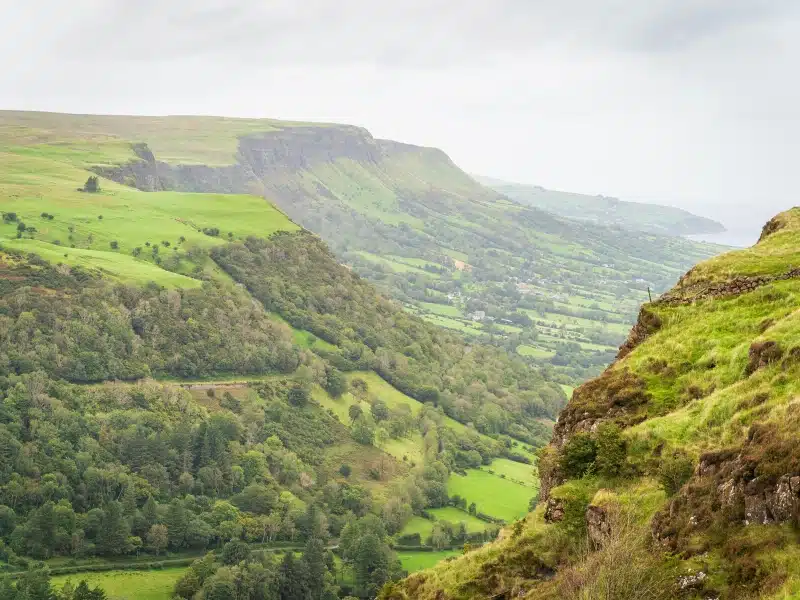
Day 3: Glenariff to Ballycastle
Cushendall Beach
As you head back to the coast from Glenariff, stop by to see pretty Cushendall Beach, which has fantastic views across the Sea of Moyle to Scotland on a clear day.
GoT Location: Cushenden Caves
Located at the southern end of the crescent-shaped Cushenden Beach, the Cushendun Caves were formed over 400 million years ago, and eroded over time by wind and water.
The caves were a key filming location in Game of Thrones and served as the backdrop for the memorable scene in season 2 where Melisandre gives birth to the shadow baby, and in season 8 as the backdrop to Jaime Lannister and Euron Greyjoy’s epic sword fight.
Because the caves are easily accessible and free to visit, you might find it busy during the summer months, but an early start will help beat the crowds.
Torr Head
As you follow the route north, you’ll pick up signs for the Torr Head Scenic Route, which takes you to the spectacular viewpoint at Torr Head, which has panoramic views of the North Channel and Mull of Kintyre on clear days.
A steep and narrow drive climbs to the top of the scenic headland, where you can take in the views and observe the remnants of an ancient promontory fort and customs house.
The road is not for the faint-hearted though, with multiple hairpin bends, steep inclines, and sharp turns. It’s also a working road with farm machinery, sheep, and oncoming vehicles and is definitely not suitable for motorhomes.
Murlough Bay
Not as easy to get to as many busier attractions, Murlough Bay is all the more glorious because you’ll probably get the whole place to yourself!
There’s not much here, just emerald green hillsides, wild nature, and unspoiled beauty to enjoy. At low tide you can walk on the golden sands, but when the tides in, the beach all but disappears.
The road is another difficult one, steep and winding with lots of blind corners, so take your time and focus on the road, not the view!
GoT Location: Fairhead
Located in the northeast corner of Northern Ireland, Fairhead is a vast dolerite cliff that rises 660 feet / 200 meters above the ocean and spans a whopping 3 miles / 5km. This natural terrain has played host to many legends, and was a filming location in season 7 of Game of Thrones, when it doubled as the castle of Dragonstone.
The incredible rock face is shaped into distinctive vertical columns like organ pipes, which formed 60 million years ago from igneous rock. The cliffs are considered one of the best traditional climbing and bouldering destinations in the British Isles and are one of the biggest expanses of climbable rock in Northwest Europe.
Whether you want to climb it, enjoy the views from it, or capture it with a drone from offshore, Fairhead is an off-the-beaten-path stop on this itinerary, and just happens to be one of our favorite places in Northern Ireland!
Rathlin Island
Located just off the coast of County Antrim, beautiful Rathlin Island is steeped in history and Irish folklore.
With a population of just 125, the island has a unique culture that draws from both Scottish and Irish traditions and is rich in history, making it a fantastic place to visit on your Causeway Coastal Route trip.
The Rathlin Ferry sails between Ballycastle and Rathlin eight times a day between April and September, taking between 30-40 minutes.
On arrival pop into the Boathouse Visitor Centre, a great place to learn about the island’s history, and then get your own Rathlin postmark at the island Post Office.
To explore the island’s natural wonders, follow the 4.8 miles / 7.7km Rathlin Trail which leads from Rathlin Harbour to the Rathlin West Lighthouse and the RSPB Light Seabird Centre. Highlights along the trail include Knockans RSPB Reserve, Kinramer Area of Special Scientific Interest, and Kebble National Nature Reserve where the cliffs and sea stacks support the largest seabird breeding colony in Northern Ireland.
Ballycastle
Ballycastle, a charming town with a picturesque marina, is nestled between the North Antrim coast and the Glens of Antrim.
Ballycastle is known for its Craft Market, which showcases local artisans’ work, and the annual Ould Lammas Fair, a traditional event featuring street performances, local produce, and horse-trading held every year on the last Monday and Tuesday of August.
This is also the perfect place to start a Causeway Coast kayaking adventure. Causeway Coast Kayaking Tours offers a variety of tours, from twilight paddles to exploring nearby Kinbane Castle, and you’ll see the coastline from a different perspective. Tours are fully guided by qualified local instructors and all equipment is provided.
Once you’ve explored Ballycastle Strand, which is a popular beach spot for swimming and surfing, find one of the town’s restaurants and cafés serving freshly caught seafood and enjoy a feast! We like The Celler, with the Early Bird menu offering particularly good value for money.
Upmarket: The Salthouse Hotel – Booking.com | Agoda
Mid-Range: Marine Hotel Ballycastle – Booking.com | Agoda
Budget: Ardaghmore B&B – Booking.com | Agoda
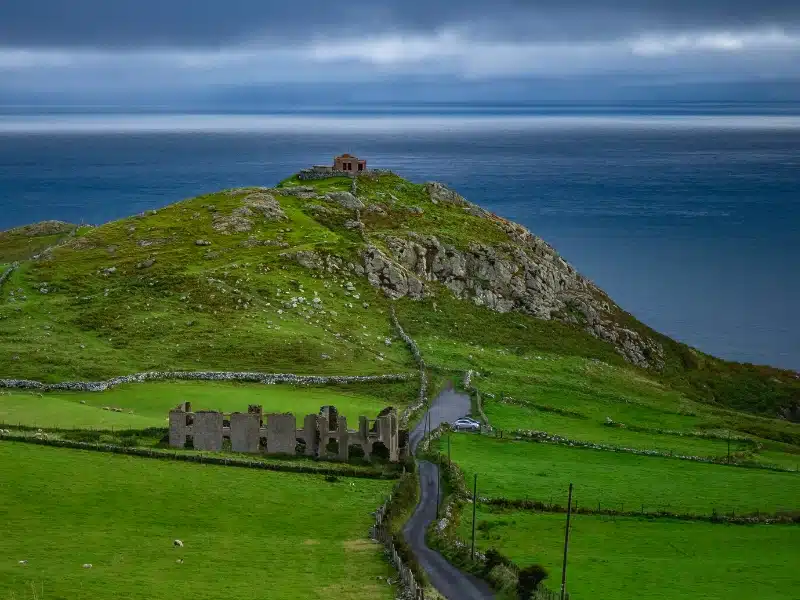
Other Nearby Road Trips
Day 4: Ballycastle to Bushmills
Today is an epic one, with several of the Causeway Coastal Route’s top highlights on the itinerary. Enjoy a traditional Ulster Fry – a cooked breakfast with sausage, bacon, eggs, black pudding, tomatoes, potato farls, and soda bread – to give you energy for the day ahead!
Carrick-a-Rede Rope Bridge
Today, the Carrick-a-Rede Rope Bridge is one of Northern Ireland’s top attractions, but the first rope bridge was erected by salmon fishermen back in 1755!
Suspended nearly 30 meters above the sea, the rope bridge connects the mainland with the tiny island of Carrickarede. Visitors can brave the thrilling walk across the rope bridge and take a 1.25 miles / 2km coastal walk over windswept cliffs and winding paths for uninterrupted views of Rathlin Island and the coastline.
It’s essential to book early online as this top Causeway Coastal Route attraction can get very busy in summer.
GoT Location: Larrybane Quarry
On the western shore of the cove is Larrybane Quarry, featured in Game of Thrones as the site of Renly Baratheon’s camp in the Stormlands in season 2, when Brienne of Tarth becomes his Kingsguard.
You can walk there in 20 minutes from Carrick-a-Rede along the cliff path, with opportunities to spot wildlife such as seabirds and basking sharks, dolphins, and porpoises, as well as taking a break for a cup of tea and slice of homemade cake at the Weighbridge Tea Room.
The whole area boasts stunning views and towering limestone cliffs, making it a popular spot for both fans of the show and nature enthusiasts.
GoT Location: Ballintoy Harbour
We love Ballintoy Harbour and Phil, who is from Northern Ireland, used to come here as a kid before it became famous as the Game of Thrones filming set for Lordsport, the port of Pyke and home of the Greyjoys.
Ballintoy Harbour is a tiny coastal village with a small harbor and rugged coastline. It’s incredibly picturesque and has long been a popular spot for those in the know. Somewhat spoiled by its GoT fame, the car park can be hard to access in summer – and don’t even attempt it in anything larger than a car!
Wander from the harbor in either direction to find secret beaches, hidden coves, and rocks which often get missed by visitors in their rush to take the iconic image of the harbor itself. They’re the perfect spot to grab fifteen minutes of peace!
Ballintoy is also a popular destination for coasteering, the sport of exploring a rocky coastline by climbing, jumping, and swimming. Ballintoy Coasteering offers adrenaline-filled adventures where you can enjoy rock climbing, learn scrambling and jumping techniques, and safely dive into the sea from great heights.
The popular walk from Ballintoy to Whitepark Bay has some fantastic sights to explore. Known as a ‘raised beach’ geologically, the sea would have once washed into the curved cliff face and both Portbraddon and Ballintoy Harbour would have been submerged. At the end of the ice age, the landmass gradually rose leaving the fantastic bay and incredible rock formations you see today.
The rock formations between the two are colloquially known as ‘The Park End’ and attract some of Ireland’s fiercest waves. One prominent volcanic stack at the east of Whitepark Bay is sometimes called the ‘Elephant Rock’, but you have to approach from the west and get the angle right to see the resemblance!
Causeway Coast Discovery Centre
Inland at Ballymoney is the Causeway Coast Discovery Centre, a fantastic place to learn about the history and culture of the area.
With interactive displays, informative exhibits, and knowledgeable staff, you can gain a deep understanding of the Causeway Coastal Route’s significance to Ireland’s heritage.
The Causeway Coast Discovery Center also offers insight into local stories and folklore, providing a unique and immersive cultural experience.
GoT Location: The Dark Hedges
The Dark Hedges is a picturesque avenue of beech trees planted in the 18th century, and it was used in Game of Thrones season 2 as the Kingsroad.
Intended as a compelling landscape feature to impress visitors as they approached the entrance to Gracehill House, a Georgian mansion, these beautiful trees remain a magnificent sight and have become one of the most photographed natural phenomena in Northern Ireland.
Dunseverick
Caution! If you do head inland you’ll miss the hamlet of Dunseverick which has a number of things to see and do. You could always come back from the Dark Hedges and back-track slightly, but this will make for a very long day.
If you decide to go, you can see the Dunseverick Falls which run off the cliffs straight into the Atlantic Ocean, and visit Dunseverick Castle, a promontory fort and an ancient royal site of the Dál Riada Gaelic kingdom.
It was said that Saint Patrick once visited Dunseverick Castle where he baptized Olcán, a local man, who later became a Bishop of Ireland.
Perhaps the best thing to do is take a swim in the Dunseverick Pool, a naturally made rock pool perfect for cooling off on hot days.
Giant’s Causeway
The UNESCO-protected Giant’s Causeway is the most famous attraction along the Causeway Coastal Route. This geological marvel consists of over 40,000 interlocking hexagonal basalt columns, formed by a volcanic eruption around 60 million years ago, although according to local legend, the columns were built by the giant Finn McCool as a causeway to Scotland.
The site has a modern visitor information center that offers interactive exhibits and information about the history and geology of the causeway, and you can take a guided tour of the site or explore independently. Booking online in advance is advised.
Visitors can walk along the columns, exploring the natural beauty and unique shapes, and try to capture the majesty of the columns as they thrust up through the sea – I say “try”, as we’ve never been able to do the Giant’s Causeway justice in photographs. Make sure to wear grippy shoes as the basalt can be slippery when wet.
Pick one of four free walking trails of various distances that offer different experiences or climb the Shepherd’s Steps and meander along the top of the Organ Pipes, hexagonal columns of solidified lava that are up to 39 feet / 12 meters tall and look uncannily just like the pipes on a grand cathedral organ.
The popular Cliff Top Experience walk is a 5 mile / 8km guided hike from Dunseverick Castle along one of the most breathtaking cliff-top views in Europe.
Taking one of the walks is a great option to escape the crowds, which can be large in summer.
Old Bushmills Distillery
A visit to the historic Old Bushmills Distillery is a must for any whiskey enthusiast, as well as those interested in local history. Established in 1608, it is the oldest licensed distillery in the world.
You can take a guided tour of the Old Bushmills Distillery, learn about the whiskey making process, and sample some of the renowned Bushmills products.
RELATED POST: Beautiful Ireland: 22 Most Scenic Places To Visit
Upmarket: Bushmills Inn Hotel & Restaurant – Booking.com | Agoda
Mid-Range: Causeway Hotel – Booking.com | Agoda
Budget: Aunt Rachel’s Barn Hostel – Booking.com | Agoda
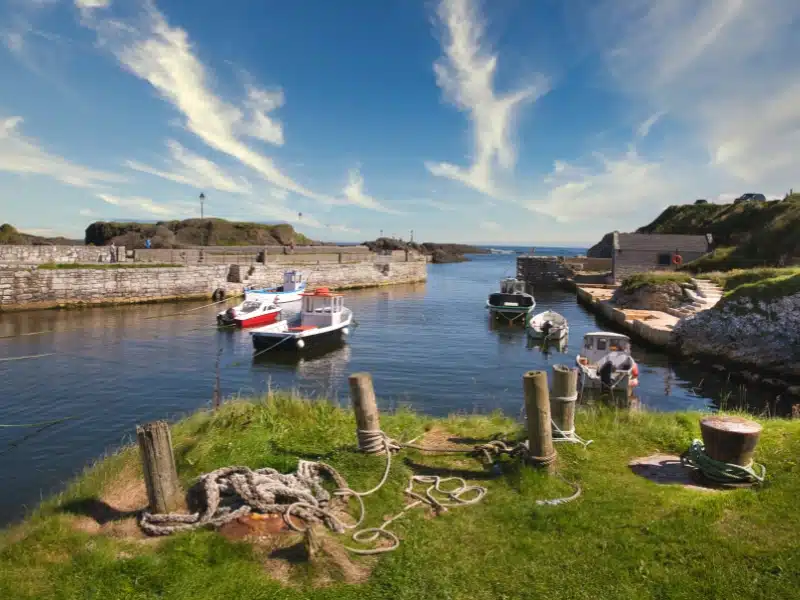
Don’t forget your road trip essentials! Our free road trip checklists help you remember everything, including road trip snacks, podcasts, and road trip songs for the journey!
Day 5: Bushmills to Portstewert
Dunluce Castle
Not far after you leave Bushmills, perched on the edge of the White Rocks cliff is medieval Dunluce Castle, a testament to Northern Ireland’s rich history.
Dating back to the 16th century, the ruins of this historic fortress which was once the seat of Clan MacDonnell offer a glimpse into the past, with tales of battles and sieges.
In 2011, major archaeological excavations found significant remains of the lost town of Dunluce, which was razed to the ground in the Irish uprising of 1641.
You can stop at the Magheracross Viewing Point on the A2 coast road for an amazing view of the castle, or cross the small stone bridge from the mainland and explore the castle grounds and ruins.
Underneath the castle is the huge 300 feet / 91-meter-deep Mermaid’s Cave, which you can explore after descending 115 steps. As with many mystical places in Northern Ireland, there is a legend attached to the Mermaid’s Cave.
The legend says that the Lord’s daughter Maeve had fallen in love with an officer in her father’s army. Maeve and her lover tried to flee the castle through the cave but a terrible storm struck and smashed their wooden boat to pieces, and they were both crushed to death on the rocks. It is said that on stormy nights you can still hear the brokenhearted ‘Banshee of Maeve’ wailing in the northeast tower to this very day.
Portrush
Portrush is a small seaside town which was originally a fishing village. In the 19th century, Portrush became a popular holiday destination, and today it is a thriving resort town, known for its beautiful beaches, lively atmosphere and the Royal Portrush Golf Club.
The town’s two main beaches, East Strand and West Strand, are popular spots for swimming and sunbathing, and there are several surf schools in the area for those looking to catch some waves. The Portrush Coastal Path to Ranmore Head is a popular walking trail that offers stunning views of the coastline and the town.
There are also plenty of amusement arcades and the ever-popular Curry’s Fun Park with its giant wheel, waltzers, and ghost train.
Portstewart
Portstewart, a charming seaside town, features a long stretch of Blue Flag beach with epic waves rolling in from the Atlantic Ocean.
The waterfront Promenade is home to lots of independent shops selling local crafts and the iconic Morelli’s, Northern Ireland’s favorite ice cream parlor.
Opposite the tiny Portstewart Harbour is our favorite food stop, 3hree Kings Coffee Company, which serves up both traditional and more contemporary breakfasts, brunches, and lunches which will more than fill you up until dinner!
The towns of Portrush, Portstewert, and Coleraine make up the triangular course of the North West 200, a famous motorbike race that takes place in Northern Ireland in May every year.
If you love bikes, you’ll be in your element here but otherwise, it’s best to avoid these dates as your road trip will most likely be disrupted by road closures.
Upmarket: Port 56 – Booking.com | Agoda
Mid-Range: Me & Mrs Jones – Booking.com | Agoda
Budget: Causeway Coast Independent Hostel – Booking.com | Agoda
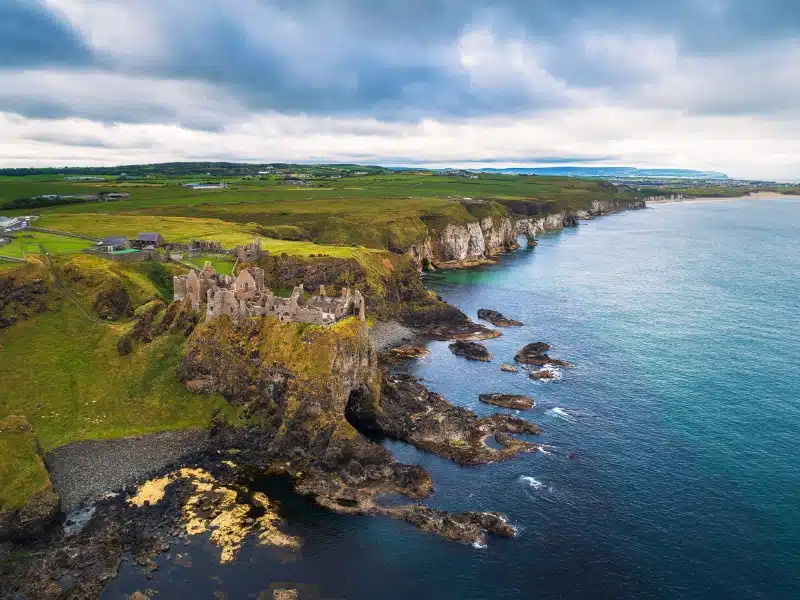
Want to plan your own road trip? Get our step-by-step road trip planning guide to help you organize the perfect trip, or check out our Europe road trip ideas.
Day 6: Portstewert to Derry/Londonderry
Mussenden Temple
The Mussenden Temple is an 18th century architectural gem, sitting proudly atop a dramatic cliff edge overlooking the Atlantic Ocean.
Built as a library and a summer retreat, the unique circular temple offers panoramic views of the surrounding coast and has become an iconic symbol of the Causeway Coastal Route.
The nearby Downhill House and gardens provide further opportunities for exploration and enjoyment of the stunning landscape.
GoT Location: Downhill Strand
Downhill Strand is a beautiful seven-mile-long beach that was featured in Game of Thrones season 2 as Dragonstone. It is the location where Stannis Baratheon draws the flaming sword from the burning effigy of the Seven.
Behind the strand in a commanding position is Downhill Beachhouse, the setting for the BBC’s B&B By the Sea television program. You can rent the restored Victorian villa for a family reunion or private party.
It’s also a lovely beach to walk on, with hard sand left by the retreating sea and interesting rocks to scramble over.
Benone Beach
A favorite of surfers, and Phil’s childhood holiday beach, Benone Beach stretches from Castlerock in the east to Magilligan Point in the west. Backed by the Umbra Nature Reserve and grassy dunes, the whole area is a wonderful place to visit.
Make sure to pop into the Sea Shed Café for amazing Spanish hot chocolate and homemade cake right on the beach!
The Longline Surf School is also based here and offers surfing lessons and equipment hire, including stand-up paddle boards and kayaks.
Magilligan Point
At the end of Benone Beach, Magilligan Point is a stunning natural reserve at the tip of one of the largest sand dune systems in the British Isles and is notable for its constantly changing coastline.
The site has been declared a nature reserve due to the way the coastline constantly changes, and the area is home to a wide range of plant and animal communities including oystercatchers, curlews, and sandpipers..
The nature reserve is open year-round, and there are several walking trails in the area that offer stunning views of the coastline and the surrounding countryside, including a distinctive Martello Tower.
You can also catch the scenic Lough Foyle Ferry from Magilligan Point to Greencastle in the Republic of Ireland, a perfect place to start a road trip of the Wild Atlantic Way along Ireland’s dramatic west coast. In the summer season, from late May to mid-September, boats run regularly throughout the day and can take cars and campers up to 6m long.
GoT Location: Binevenagh
Binevenagh, an Area of Outstanding Natural Beauty, was used as a filming location in Game of Thrones season 5 when Daenerys is spotted and surrounded by a Dothraki horde.
But the mighty Binevenagh is so much more than a filming location. Formed by molten lava 60 million years ago, Binevenagh’s sheer cliffs extend for over six miles and dominate the surrounding landscape between Derry/Londonderry and the delightful Castlerock, guarding the spectacular coastline.
Hike to the summit through evergreen forest for incredible views of Lough Foyle, and on a clear day, the west coast of Scotland. If you’re not a hiker, drive the Bishop’s Road and stop at the Gortmore View Point, for the same views and the sculpture of Manannan Mac Lir, a local sea god.
Derry/ Londonderry
Head south to Derry/Londonderry where you’ll have time to grab a bite before you’ll want to go to bed! Never fear, you have a full day to explore the Walled City tomorrow.
Upmarket: Bishop’s Gate Hotel – Booking.com | Agoda
Mid-Range: The Ebrington Hotel – Booking.com | Agoda
Budget: Number 8 The Townhouse – Booking.com | Agoda
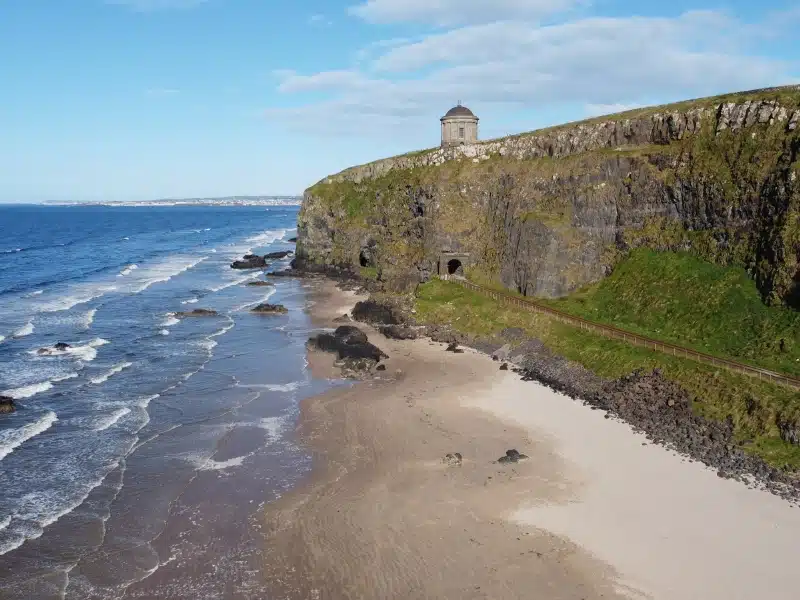
Day 7: Derry/Londonderry
Londonderry, also known as Derry, and in Irish Doire (meaning ‘oak grove’) is the final destination on the Causeway Coastal Route. This historic almost intact walled city on the banks of the River Foyle boasts a rich cultural and political history.
In fact, Derry/Londonderry is one of the few cities in Europe that never saw its fortifications breached, withstanding several sieges, including the famous Siege of Derry in 1689 which lasted 105 days; hence the city’s nickname, the Maiden City.
The city can be dated as far back as the 6th century when it was founded by Saint Columba. More recently, Derry played an important role in the Troubles, a period of conflict in Northern Ireland that lasted from the late 1960s to the late 1990s. Today, the city is a vibrant cultural center, known for its historic landmarks, lively nightlife, and friendly locals.
The city’s most famous landmark is its 17th century walls, which are among the best-preserved city walls in Europe. The walls offer stunning views of the city, including a bird’s eye view of the famous Derry Girls mural located on the side of Badger’s Bar and Restaurant opposite the Foyleside shopping center, and are a popular spot for a leisurely stroll.
The city is also home to several excellent museums, including the Tower Museum, where you can learn about the history of Derry from its earliest days to the present, and the Museum of Free Derry which tells the people’s story of government oppression, the struggle for civil rights, the descent into conflict, Free Derry and Bloody Sunday.
The nearby Bogside area is home to several famous murals that tell the story of the Troubles, and visitors can take this excellent Bogside guided tour to learn more about this important period in Northern Ireland’s history.
Other attractions include the reconstructed 18th century Craft Village, the Gothic St. Columb’s Cathedral, and the contemporary Peace Bridge across the River Foyle, which connects the city center with Ebrington Square, a former military heritage site.
From here, you can head back to Belfast on the picturesque A6, over the Glenshane Pass in the Sperrin Mountains. It will take around 1 hour 10 minutes to reach Belfast International Airport and 1 hour 20 minutes to Belfast City Airport.
Alternatively, you can fly out from the City of Derry Airport, a 15 minute drive from the city centre.
RELATED POST: 10 Best Cities on the Island of Ireland for an Amazing Visit!
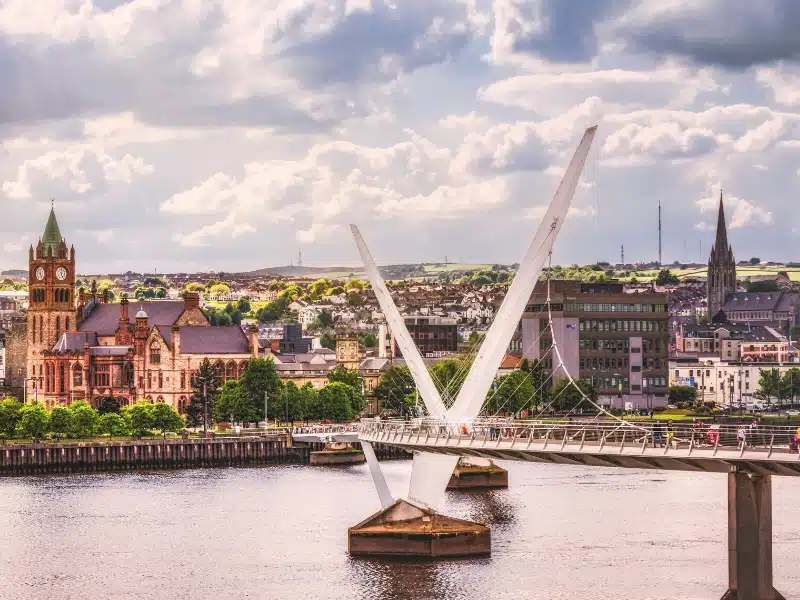
Northern Ireland Road Trip Resources
Here are the websites and services we personally use and recommend for traveling in Northern Ireland.
Tips for Driving & Traveling in Northern Ireland
Whether you’re road tripping the Causeway Coastal Route in a car, camper, or motorbike, make sure you’ve got all your documents handy and your spare tire is in good condition. There is a limited cell phone signal in some areas – it may be easier to print important documents before leaving, rather than risk having no 4g along the route!
- Remember that Northern Ireland, just like England, Scotland, and Wales, drives on the left and overtakes on the right.
- You require a valid driving license.
- Drivers from non-EU countries may require an International Driving Permit. The general rule is that if your license is not in English, then an IDP will be required. Check with your hire company or embassy if you’re in doubt.
- If you’re not a British citizen, you should carry your passport or ID card at all times as you road trip the Causeway Coast Route.
- You must have at least 3rd party insurance for your vehicle. If you’re hiring a vehicle this is all taken care of by the rental company.
- Your car must be considered roadworthy in the country in which it is registered.
- Your headlights must be adapted for driving on the right if your vehicle is registered outside the UK.
- Unlike France, the UK does not have laws that require you to carry certain equipment in your car, but that doesn’t mean that you shouldn’t. Being prepared in the event of an accident or a breakdown is invaluable. Ideally, you should carry a reflective jacket, a warning triangle, a first-aid kit and a fire extinguisher, and key safety equipment which should be provided by the hire company.
RELATED POST: Driving in Europe – Everything You Need to Know
Are you looking for more road trip inspiration? Check out these top posts…
European Road Trip: Six Countries in 90 Days
Norway Road Trip: Four Unmissable Routes
Germany Road Trip: 8 Unmissable Routes
The Perfect Andalucia Road Trip: 10-14 Day Itinerary
The Ultimate Bucket List Italy Road Trip
Spring Road Trip from Britain to Portugal
Love it? Pin it!
